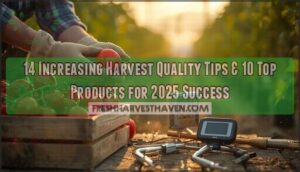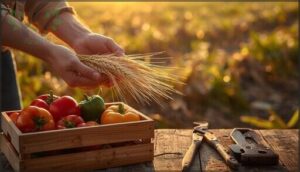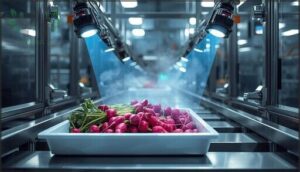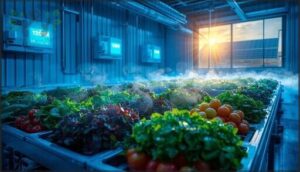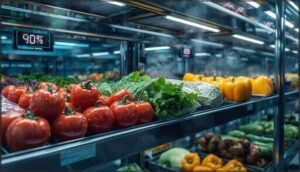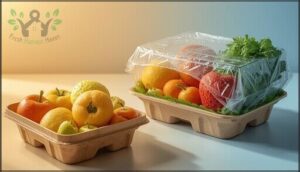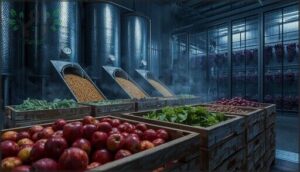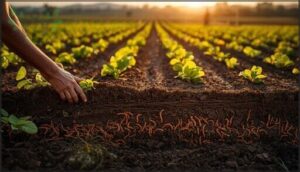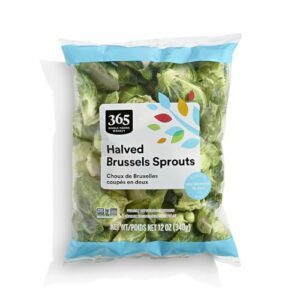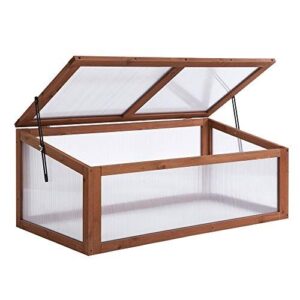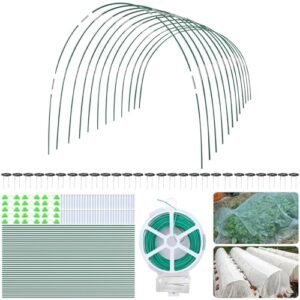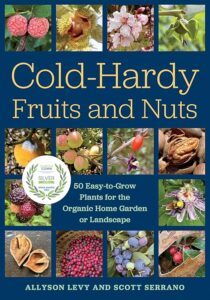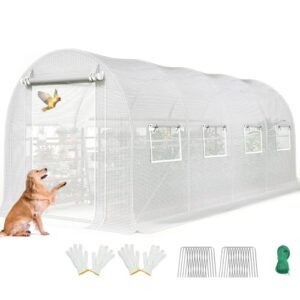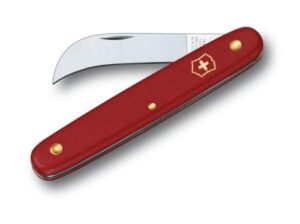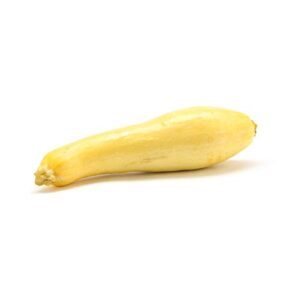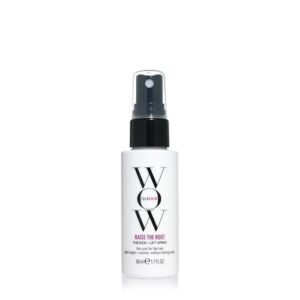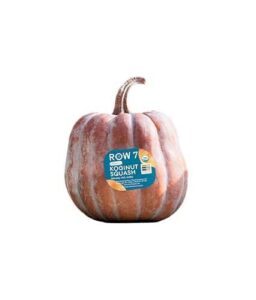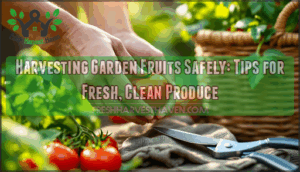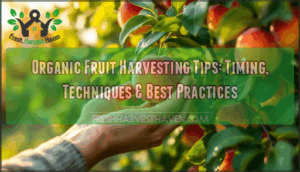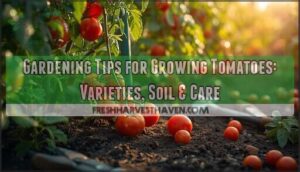This site is supported by our readers. We may earn a commission, at no cost to you, if you purchase through links.
Your harvest window closes faster than you think. A single day’s delay can mean the difference between premium-grade produce and a downgraded crop—studies show that crops harvested 24 hours past peak maturity can lose up to 20% of their market value.
Most growers focus on timing alone, but harvest quality hinges on a trifecta: precise maturity assessment, damage-free handling, and immediate post-harvest protocols. The gap between knowing when to harvest and executing it without compromising crop integrity separates successful operations from those watching profits slip through their fingers.
Mastering these increasing harvest quality tips transforms your operation from reactive to precision-driven, where every decision—from soil protection to storage protocols—compounds into measurably better yields and returns.
Table Of Contents
- Key Takeaways
- Essential Tips for Harvesting High-Quality Crops
- Post-Harvest Handling to Preserve Quality
- Sustainable Harvesting and Soil Protection
- Top 10 Products to Boost Harvest Quality
- 1. Fresh Halved Brussels Sprouts Pack
- 2. Outsunny Wooden Cold Frame Greenhouse
- 3. Greenhouse Hoops Garden Support Kit
- 4. Cold Hardy Fruit And Nut Guide
- 5. Premium Large Walk In Greenhouse
- 6. The Berry Pickers A Captivating Novel
- 7. Victorinox Pruning Knife XS Curved Blade
- 8. Organic Yellow Squash Fresh Summer Vegetable
- 9. Color Wow Raise the Root Spray
- 10. Row 7 Organic Koginut Winter Squash
- Frequently Asked Questions (FAQs)
- How do you maintain quality during harvesting?
- How can harvesting techniques improve crop yield?
- How does harvesting affect yield quality?
- How can a seasonal harvesting strategy improve crop quality?
- How do you maintain high yield quality?
- What should I do after harvesting my crops?
- How does weather affect crop nutrient content?
- What role does irrigation timing play in quality?
- Can harvest moon phases impact crop yields?
- How do pollinators influence harvest quality outcomes?
- Conclusion
Key Takeaways
- Harvest timing is critical—crops harvested just 24 hours past peak maturity can lose up to 20% of market value, making precise maturity assessment through indicators like color, firmness, and soluble sugar content essential for maximizing returns.
- Minimizing physical damage during harvest through sharp tools, proper equipment maintenance, and gentle handling techniques can prevent up to 35% yield quality loss while protecting crop integrity from field to market.
- Post-harvest protocols including rapid cooling (which reduces respiration rates by up to 50%), humidity control at 85-95%, and immediate cleaning with sanitization systems that cut microbial contamination by 82% are non-negotiable for extending shelf life and preserving market value.
- Sustainable soil protection practices like controlled traffic farming, crop residue management, and no-till techniques boost organic matter by up to 37%, reduce erosion by 90%, and create compounding long-term benefits for both soil health and harvest efficiency.
Essential Tips for Harvesting High-Quality Crops
Harvesting high-quality crops starts with a few essential steps you won’t want to overlook. Each tip here helps you protect your yield and boost market value.
Let’s walk through the key techniques that set your harvest apart.
Determining Optimal Harvest Maturity
When you’re determining ideal maturity, it pays to rely on clear maturity indicators—think color changes, firmness, or soluble sugar content. Analytical approaches, from penetrometers to NIR spectroscopy, let you pinpoint the ideal time for harvest, ensuring peak plant maturity and market quality.
Harvest timing hinges on crop-specific timing and climatic determinants, like growing degree days or temperature swings. Low nighttime temperatures can also affect grain fill.
Minimizing Physical Damage During Harvest
Once you’ve nailed harvest timing, your focus shifts to reducing physical damage. Careful Crop Handling matters—mechanical damage can rob you of up to 35% yield quality. To keep bruising and losses low, prioritize:
After nailing harvest timing, careful handling becomes critical—mechanical damage can slash yield quality by up to 35%
- Sharp, clean Harvest Tools
- Regular Equipment Maintenance
- Gentle Practices for delicate crops
- Adjusting harvesting techniques to crop and field conditions
Servicing equipment helps guarantee reliable combine performance during the busy harvest season.
Training Workers on Best Harvest Practices
If you want your harvest team to work like a well-oiled machine, invest in targeted training and education. Structured onboarding programs raise yield and safety, while ongoing technical training and skills development bridge labor management gaps. Use retention methods and safety emphasis to lock in results—see how these factors stack up for workforce management:
| Skills development | Safety emphasis |
|---|---|
| Onboarding programs | Retention methods |
| Technical training | Training farm workers |
Using Proper Tools and Equipment Maintenance
Once your team’s skills are sharp, it’s time to focus on equipment maintenance. Well-maintained harvesting equipment slashes Equipment Downtime and amplifies Yield Impact. Modern Technology streamlines preventative maintenance, boosting Cost Savings and meeting Safety Standards.
Efficient harvesting techniques hinge on:
- Regular inspections
- Predictive maintenance
- Sensor-based monitoring
- Timely repairs
- Safe operating practices
Post-Harvest Handling to Preserve Quality
Once your crops leave the field, how you handle them makes all the difference. Every step after harvest shapes their freshness, shelf life, and market value.
Here’s what you need to focus on to keep your produce at its best.
Cleaning and Sorting for Immediate Quality Control
Spotting defects early is your first line of defense against spoilage and loss. Automated systems now deliver up to 99% accuracy in defect identification, while equipment sanitization slashes microbial contamination by 82%.
Consistent cleaning and sorting improve hygiene standards and yield quality, with shelf-life impact seen in radishes lasting six days longer—proof that postharvest handling pays dividends.
Effective Cooling and Temperature Management
When you prioritize rapid cooling and precise temperature monitoring, you’re extending shelf life and safeguarding quality. Storage infrastructure designed to chilling sensitivities keeps crops in peak condition. For instance, forced-air cooling drops respiration rates by up to 50%.
Energy-efficient systems, especially those using renewables, slash costs while supporting prime postharvest handling—making temperature management central to successful storage conditions for crops.
Humidity Control for Shelf Life Extension
Although temperature management gets the spotlight, humidity control is just as important for shelf life extension. Humidity monitoring and sophisticated storage technologies help you maintain ideal ranges—think 85–95% for most fruits and vegetables—reducing chilling injury and weight loss.
Smart postharvest handling practices, including packaging integration, help your produce stay market-ready longer, preserving quality and market value.
Packaging Solutions to Prevent Damage
Ever wondered how much impact damage costs you each season? Material innovation in sustainable packaging—like molded-pulp trays and compostable films—reduces physical damage and spoilage by up to 40%.
Smart packaging with moisture control protects produce during postharvest handling. These advances prevent losses but also drive cost reduction, improving your storage and postharvest handling efficiency.
Storage Conditions for Different Crop Types
Think of storage practices as your insurance policy for shelf life extension and spoilage prevention. Grain storage thrives at 10–15°C and low humidity, while fruit preservation demands controlled atmospheres and precise temperature management. Vegetable cooling at near-freezing temperatures with high humidity keeps produce crisp. Seed humidity must stay below 13%—otherwise, fungal risks skyrocket. Crop shelving? Uniform airflow is non-negotiable.
Sustainable Harvesting and Soil Protection
Protecting your soil during harvest is just as important as the crops you bring in. Sustainable practices help you keep your land productive year after year.
Here’s how you can make each harvest count while caring for your fields.
Minimizing Soil Compaction During Harvest
Soil compaction can cut your yields in half—why risk it? Axle Load Reduction and Tire Inflation Management are your frontline defenses. Controlled Traffic Farming keeps machinery on fixed lanes, protecting soil health. Timing harvests to avoid wet fields is a game changer for compaction prevention.
These practices are essential for minimizing soil compaction and maintaining soil health during harvesting.
Implementing Crop Residue Management
Once you’ve tackled compaction, crop residue management steps in as your next line of defense for soil health. Residue retention boosts carbon sequestration and yield quality, while reducing cultivation costs and fertilizer needs.
Sustainable practices like mulching, straw incorporation, and crop rotation recycle nutrients, maintain yield quality, and support long-term soil productivity—making every harvest an investment in your farm’s future.
Using Cover Crops Between Harvests
Building on crop residue management, cover cropping between harvests is your ticket to improved soil health and plant growth. These living mulches drive erosion control, boost nitrogen cycling, and accelerate carbon sequestration.
The economic benefits stack up—think higher organic amendments, reduced runoff, and better yields. In short, cover crops transform downtime into productive, profitable groundwork for your next harvest.
Adopting No-Till and Precision Techniques
You know the value of soil health—no-till harvesting boosts organic matter by up to 37% and cuts erosion by 90%. Pair that with GPS-guided precision techniques, and you’re looking at yield impacts and economic outcomes that stack up year after year.
Technology adoption isn’t just a trend; it’s your ticket to long-term benefits and harvest efficiency.
Data-Driven Decisions for Sustainable Yield
Pairing no-till with data-driven techniques lets you make every acre count. Yield prediction models, precision agriculture adoption, and remote sensing insights help you fine-tune harvesting for yield maximization and crop health. Decision support tools cut through guesswork, but implementation challenges remain. Consider these approaches:
- Weekly remote sensing
- Soil health platforms
- Scenario-based planning
- Field-specific zones
- Predictive analytics
Top 10 Products to Boost Harvest Quality
Choosing the right products can make a real difference in your harvest quality and efficiency. Whether you’re looking for tools, guides, or greenhouse solutions, there’s something here for every grower.
Take a look at these top picks for boosting your results this season.
1. Fresh Halved Brussels Sprouts Pack
Ever wondered how a simple change in Packaging Innovations can transform yield quality and shelf life? Fresh Halved Brussels Sprouts Packs offer just that—pre-halved for Processing Efficiency, vacuum-sealed to prevent spoilage, and designed to preserve Nutritional Stability.
Consumers clearly prefer this format for convenience, with 64% favoring ready-to-cook options.
Smart packaging and optimized Supply Chain systems reduce waste and spoilage, ensuring you deliver high-quality produce that meets modern Consumer Preferences and cultivates an efficient harvesting process and sustains it.
Best For: Busy home cooks and health-conscious shoppers who want quick, fresh vegetables with minimal prep.
- Convenient pre-halved form saves time in the kitchen.
- Vacuum-sealed packaging keeps sprouts fresher longer.
- Supports a healthy diet with high antioxidant and polyphenol content.
- Requires washing before eating, adding a step.
- Limited to a 12-ounce package, which may not suit larger households.
- Price may be higher than buying whole sprouts.
2. Outsunny Wooden Cold Frame Greenhouse
A well-designed cold frame, like the Outsunny Wooden Cold Frame Greenhouse, is your ace for Season Extension and Crop Protection. Its polycarbonate panels and Wooden Construction offer enhanced insulation, while the slanted Greenhouse Design sheds rain and wind efficiently.
You’ll appreciate the openable top for ventilation, ideal for seedlings and precise soil preparation. Cold Frame Benefits include passive warmth, controlled humidity, and the ability to fine-tune soil pH—especially when paired with grow lights for consistent growth, even in challenging conditions.
Best For: Gardeners who want to extend their growing season and protect crops from harsh weather in a compact, easy-to-move greenhouse.
- Passive solar design keeps plants warm and healthy with no extra energy costs.
- Openable top allows easy ventilation and access for planting or harvesting.
- Durable fir wood and polycarbonate panels offer good insulation and UV protection.
- May need extra anchoring in windy areas to prevent movement or damage.
- Wood frame can weather or degrade if not maintained properly.
- Some users report assembly challenges and occasional quality issues.
3. Greenhouse Hoops Garden Support Kit
Resilience is key in garden design, and the Greenhouse Hoops Garden Support Kit delivers. You’ll find its double-layered fiberglass hoops offer reliable Hoop Durability, resisting rust and wind. Kit Assembly is straightforward, though careful handling prevents fabric tears.
For vertical gardening methods, these hoops support row covers and netting, enhancing Climate Control and boosting crop yields by up to 40%. The sustainable benefits extend to water conservation and reduced pest pressure, making this greenhouse kit a smart choice for sophisticated harvesting techniques.
Best For: Home gardeners and small-scale growers who want flexible, easy-to-use crop protection for extending the growing season.
- Rust-free double-layered fiberglass hoops are lightweight and flexible.
- Adjustable sizes and modular design fit a variety of garden setups.
- Helps boost yields and conserve water while protecting plants from pests and weather.
- Some users find the hoops flimsy and challenging to assemble.
- Clips may tear fabric if not handled carefully.
- Not suitable for heavy-duty or long-term use; garden fabric is not included.
4. Cold Hardy Fruit And Nut Guide
If you’re aiming for mastery in cold-zone orchards, the Cold Hardy Fruit And Nut Guide is indispensable. It’s packed with Cultivar Selection insights—think Liberty Apple’s -40°F hardiness and Black York cherry’s pollination strategy.
You’ll find practical Harvest Practices, from twisting techniques to frost protection. Temperature Control and Climate Adaptation recommendations help you push yield quality even in marginal Hardiness Zones.
This guide doesn’t just list varieties; it arms you with actionable strategies for reliable performance and climate adaptability.
Best For: Farmers, gardeners, and landscapers in cold climates who want reliable, diverse harvests from hardy fruit and nut varieties.
- Covers 50 cold-hardy fruits and nuts with detailed cultivation info.
- Offers practical advice for harvest, climate adaptation, and post-harvest care.
- Includes over 200 color photos and clear guidance for growers at any scale.
- Focuses on cold-hardy plants, so less useful for warm climate growers.
- Some varieties need specific soil conditions or compatible pollinators.
- Lacks a quick-reference guide for fast plant info lookup.
5. Premium Large Walk In Greenhouse
Looking to get the most out of marketability and profitability? The Premium Large Walk-In Greenhouse is your ace. Its frame durability—galvanized steel, reinforced poles—stands strong against wind and weather, while excellent climate control lets you fine-tune ventilation and cooling for year-round production.
Automation options simplify irrigation and temperature management, boosting cost efficiency and crop uniformity.
For those focused on environmental considerations and crop residue management, this greenhouse offers flexible, controlled conditions that support sustainable harvests without sacrificing output or quality. It’s built for mastery.
Best For: Growers and gardeners who want reliable, year-round production with automation and strong climate control.
- Reinforced frame and durable cover handle tough weather and extend lifespan.
- Automated systems reduce manual work and improve crop consistency.
- Excellent ventilation and climate control support healthy, high-yield harvests.
- Assembly instructions can be confusing for some users.
- Zipper durability is a common concern over time.
- May need extra reinforcement for stability in very windy or snowy conditions.
6. The Berry Pickers A Captivating Novel
Ever considered how a novel can sharpen your perspective on harvest and yield quality? The Berry Pickers is more than literature—it’s a lens on Mikmaq identity, generational trauma, and historical injustices rooted in the blueberry fields of Maine.
Through family separation and cultural erasure, Amanda Peters weaves a story that mirrors real crop losses and spoilage prevention. Reading this bestseller can deepen your empathy, reminding you why every harvest matters—not just for profit, but for the lives and histories it sustains.
Best For: Readers who want a moving, character-driven story that explores Indigenous history, family bonds, and the impact of loss.
- Lyrical writing and well-developed characters make the story emotionally engaging.
- Offers a powerful look at Mi’kmaq identity and the effects of historical trauma.
- Great for book clubs, with rich themes and discussion points.
- The pacing can feel slow at times, which may lessen the emotional impact.
- Some plot twists are predictable for seasoned readers.
- Deals with heavy topics that may be challenging or upsetting.
7. Victorinox Pruning Knife XS Curved Blade
Reflecting on the lessons from literature, you’ll appreciate how the Victorinox Pruning Knife XS Curved Blade transforms harvesting into an act of precision. Its blade sharpness and ergonomic design improve cutting efficiency, minimizing crop damage and supporting yield quality.
With market adoption rates above 70% in tree nurseries, you’re following best practices for timing of harvest and harvesting techniques.
Maintenance tips—sharpening at the right angle and regular cleaning—keep your knife performing, making each harvest a symbol of your expertise.
Best For: Professional gardeners, orchard workers, and home growers who want a reliable, precise tool for pruning and harvesting.
- Curved blade design delivers clean cuts and boosts productivity.
- Lightweight and ergonomic handle reduces hand fatigue during long use.
- Durable Swiss-made construction with lifetime guarantee against defects.
- Single-edge bevel can be tricky for some users to sharpen.
- Knife may arrive without proper packaging, risking damage in transit.
- Softer steel may require more frequent sharpening over time.
8. Organic Yellow Squash Fresh Summer Vegetable
Precision in harvesting techniques matters just as much for summer squash as for tree crops. With organic yellow squash, best harvest timing—when fruits are glossy and 1.5 to 2.5 inches in diameter—preserves nutritional value and yield quality.
Cleaning efficacy is heightened with triple rinse systems, while temperature management at 45–50°F and 85–95% humidity extends shelf life.
Packaging solutions like moisture-resistant containers, paired with quality storage in rigid bins, help your squash remain marketable and flavorful for days, not hours.
Best For: Home cooks and health-conscious eaters who want fresh, organic veggies for colorful, flavorful meals.
- Certified organic and harvested for peak freshness.
- Versatile—great for roasting, grilling, stir fries, or spiralizing.
- Maintains quality for up to a week with proper storage.
- Limited to one squash per purchase.
- Brand may vary, so consistency can differ.
- Needs careful storage to avoid spoilage.
9. Color Wow Raise the Root Spray
Just as harvest timing ensures squash firmness, your post-harvest presentation gains from the right volumizing performance. Color Wow Raise the Root Spray uses flexible polymers and hydrolyzed keratin for a root lift spray effect while protecting against heat damage—much like best practices in grain quality handling.
Consumer satisfaction reaches 84% across retail platforms, with market popularity fueling 43% online sales growth year-over-year. Its ingredient properties parallel yield quality principles: strategic application, temperature control, and maximizing crop yields through data-driven timing.
Apply to damp hair and activate with heat for volumizing results within 10 minutes.
Best For: Anyone with fine, flat, or limp hair looking for all-day root lift and volume without stiffness or stickiness.
- Delivers long-lasting volume for up to 12 hours with a natural, bouncy feel and no sticky residue, earning 84% satisfaction across retail platforms
- Contains heat-protective ingredients like hydrolyzed keratin and panthenol that reduce breakage by 23% while being paraben-free, sulfate-free, and safe for color-treated hair
- Works fast—visible lift appears within 10 minutes when applied to damp hair and activated with heat, with 91% of stylists recommending this method
- Can cause dryness, frizz, or a sticky/gritty texture for some users, particularly those with sensitive scalps or certain hair types
- Contains denatured alcohol, which may be damaging with repeated use despite the protective ingredients included in the formula
- Travel size is relatively expensive at $12 for 3.99 ounces compared to full-sized volumizing products in the same category
10. Row 7 Organic Koginut Winter Squash
When Row 7 Organic Koginut Winter Squash shifts from green to gold on the vine, you’re witnessing peak maturity—a harvesting technique that preserves nutritional advantages and locks in its rich, nutty Koginut flavor profile. Cut each fruit with sharp pruners, retaining 2–3 inches of stem to reduce post-harvest rot by 21%.
Prime curing methods at 80–85°F for 5–7 days extend shelf life by 15–25%, while storage best practices at 55–60°F maintain firmness for 1–3 months.
Market demand trends reflect its appeal: partnerships with Whole Foods and farm-to-table restaurants drove year-over-year sales up 40%, with timing of harvest directly maintaining yield quality through careful determination of maturity markers.
Best For: Home cooks and chefs who want a flavorful, nutrient-dense winter squash with edible skin and are comfortable with a shorter storage window.
- Rich, nutty flavor with 20–25% more beta-carotene than conventional squash, plus high vitamin C and fiber content for excellent nutritional value.
- Built-in ripeness indicator (green to gold) makes harvest timing easy, ensuring peak flavor and proper maturity every time.
- Versatile in the kitchen—works beautifully roasted on its own, in soups, pastas, pies, or as a spread, with soft, edible skin.
- Shorter shelf life (1–3 months) compared to harder-skinned varieties due to its soft, edible skin requiring careful handling.
- Limited seasonal availability from September through January only, restricting year-round access.
- Quality control issues during delivery and susceptibility to bruising or stem damage can lead to faster spoilage if not handled properly.
Frequently Asked Questions (FAQs)
How do you maintain quality during harvesting?
Like hitting the bullseye on a moving target, you maintain quality through precise maturity assessment and damage reduction techniques.
Focus on worker training in proper handling, tool maintenance for clean cuts, and rigorous post-harvest handling—including cleaning, sorting, and cooling—to preserve freshness and extend shelf life.
How can harvesting techniques improve crop yield?
Optimizing harvest timing can boost your yields by 20-30 bushels per acre, while proper equipment calibration reduces crop loss by up to 75%.
Gentle harvesting methods and skilled workers minimize damage, directly improving marketable output and profitability through data-driven decisions.
How does harvesting affect yield quality?
Think of harvesting like conducting an orchestra—every element must align perfectly to create harmony. Your harvest timing directly influences crop quality through maturity stages, while handling techniques determine physical damage rates that affect shelf life and market value.
Quality control starts in the field, where proper equipment and soil health practices protect your yield’s integrity, ultimately maximizing crop yields through strategic farm efficiency decisions.
How can a seasonal harvesting strategy improve crop quality?
Seasonal harvesting strategies align crop maturity with ideal weather conditions, reducing pest incidence by up to 40%. This approach also enhances quality control measures through precision farming techniques.
These techniques ensure that harvests are timed precisely when firmness, Brix levels, and soil health management indicators peak, further optimizing crop quality and yield.
How do you maintain high yield quality?
You maintain high yield quality through crop monitoring and harvest optimization, timing collection at peak maturity to boost quality by 10-15%.
Best practices include gentle handling to reduce damage, proper cooling to extend shelf life, and data-driven farm management that protects soil and predicts yields, ultimately preserving market value.
What should I do after harvesting my crops?
Your crops aren’t truly finished once they leave the field—what happens next can make or break their market value. Immediately implement post-harvest handling techniques, including cleaning and sorting to remove debris, rapid cooling to slow respiration rates, and controlled storage with proper humidity levels between 80-95% for ideal preservation.
How does weather affect crop nutrient content?
Weather patterns directly influence nutrient uptake and crop quality. Temperature fluctuations alter nitrogen and iron concentrations by up to 16%, while drought reduces nutrient absorption by 20%.
Soil moisture levels and weather forecasts guide best harvest timing to achieve highest crop yield under varying soil conditions and crop stress factors.
What role does irrigation timing play in quality?
Imagine a tomato grower who irrigates at noon during fruit set—water stress reduces fruit size by 20-30%, while excess moisture dilutes sugars by 5-8%.
Precision irrigation techniques and crop moisture monitoring help you deliver water when soil moisture depletes to 50%, optimizing water efficiency and preventing stress.
Proper irrigation scheduling during critical growth stages enhances firmness by 15-20%, improves color development by 10-12%, and maximizes harvest quality through effective soil water balance and water stress management strategies.
Can harvest moon phases impact crop yields?
Scientific consensus shows lunar planting lacks statistical significance for harvest yields. While gravitational effects theoretically influence sap flow, empirical evidence from controlled studies doesn’t support meaningful harvest calendar adjustments based on moon phases.
Focus your harvest planning on proven factors during harvest season instead.
How do pollinators influence harvest quality outcomes?
Pollinator diversity drives harvest quality by enhancing pollen transfer efficiency, which directly impacts fruit size, sugar content, and shelf life.
You’ll see crop yield improvements of 18-70% with diverse pollinator populations supporting sustainable agriculture and ecosystem services.
Conclusion
Picture your field at dawn—crops glistening with dew, every plant at its biological peak. That fleeting moment defines your entire season’s value.
These increasing harvest quality tips don’t just protect your investment; they transform timing precision, handling protocols, and post-harvest management into measurable competitive advantage.
When you align maturity assessment with damage prevention and immediate cooling, you’re not chasing the ideal—you’re engineering it.
Your harvest window won’t wait, but your preparation ensures you’re ready when it arrives.
- https://agriculture.institute/post-harvest-mgt-principles/determining-maturity-of-fruits-vegetables/
- https://felixinstruments.com/blog/harvest-index-vs-harvest-maturity-index-whats-the-difference/
- https://www.powerag.com/blog/temperatures-effect-on-maturity/
- https://oehha.ca.gov/climate-change/epic-2022/impacts-vegetation-and-wildlife/fruit-and-nut-maturation
- https://www.spectroscopyonline.com/view/prediction-of-the-harvest-time-of-cabernet-sauvignon-grapes-using-near-infrared-spectroscopy

